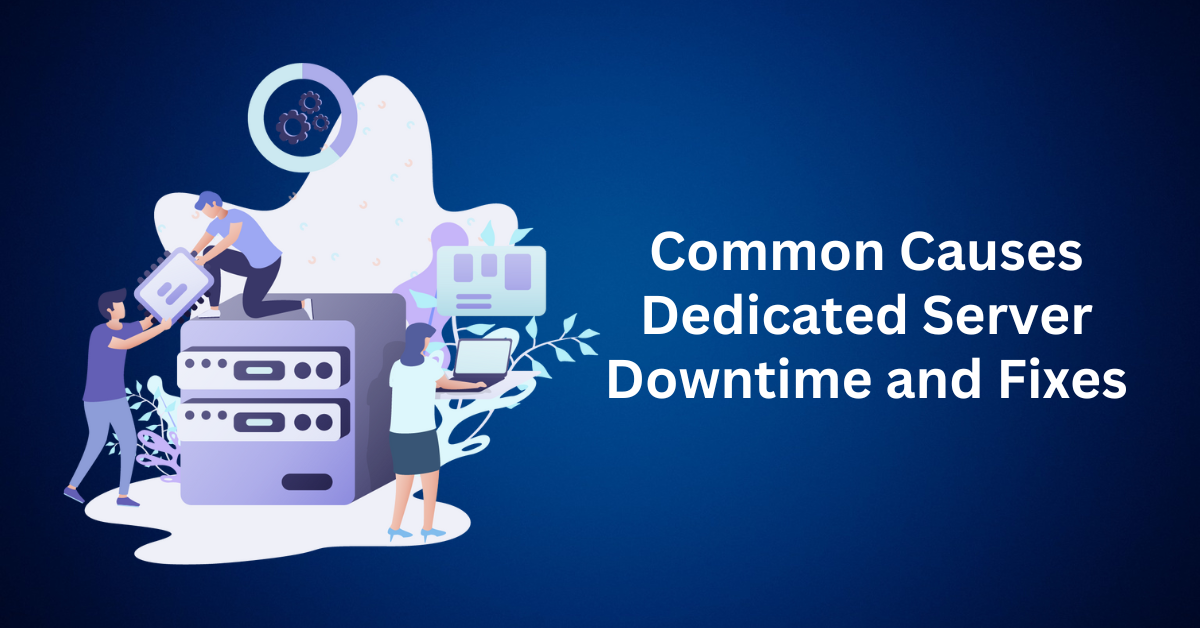When your dedicated server goes offline, the impact is immediate and potentially costly. Whether you’re running an eCommerce website, SaaS application, or content platform, unexpected server downtime can lead to lost revenue, broken user experiences, and long-term damage to your online reputation.
But what exactly causes server downtime? And more importantly, how can you minimize its risk?
In this guide, we’ll explore the most common causes of dedicated server downtime, actionable ways to troubleshoot them, and how hosting solutions like Bluehost’s dedicated servers can help you stay online with minimal interruptions.
Table of Contents
ToggleWhat Is Dedicated Server Downtime?

Dedicated server downtime refers to any period when your server is unable to deliver content, applications, or services to users. This can mean the server is completely unreachable, or it could involve performance issues such as timeouts, failed API responses, or incomplete page loads.
While short-term, scheduled maintenance windows are normal in server management, unexpected downtime, especially prolonged outages, signals deeper technical or infrastructural problems.
Why Dedicated Server Downtime Matters
Even a few minutes of unplanned downtime can ripple across your digital ecosystem. Here’s how it affects your business:
- User Experience Degradation: Slow-loading pages or complete inaccessibility frustrate users, increase bounce rates, and harm your conversion rates.
- Damaged Brand Trust: Frequent outages erode credibility, especially for businesses promising 24/7 availability.
- Lost Sales Opportunities: If your server goes down during peak hours or promotional campaigns, it directly impacts revenue.
- SEO Penalties: Google bots encountering downtime may remove or de-rank your pages in search results.
- Internal Disruption: APIs, CRMs, and internal tools, depending on server availability, may stop functioning, affecting productivity.
What Are the Most Common Causes of Dedicated Server Downtime?
To minimize disruptions and protect your online operations, it’s essential to first understand why dedicated servers go down. In most cases, downtime falls into one of three categories: physical hardware failures, software-level issues, or operational missteps. Each of these presents its own risks, and moreover, if left unaddressed, they can quickly escalate into prolonged outages and significant financial losses.
Let’s explore the six most frequent causes of downtime in dedicated hosting environments and what they mean for your business.
1. Hardware Failures: When the Foundation Breaks
Despite the reliability of enterprise-grade hardware, physical components aren’t immune to failure. Power supply interruptions, failing RAM modules, or overheating CPUs can instantly take your server offline. Even in professionally managed data centers, a single hardware fault can cripple services until replacements are sourced and systems are restored.
Why it matters: Hardware issues often strike without warning, and without hardware redundancy in place, you risk complete service outages and potential data loss.
2. Disk Crashes: A Silent Threat to Your Data
Storage drives, especially traditional HDDs, are prone to degradation over time. A disk failure can lead to lost databases, corrupted logs, and inaccessible applications. And if you don’t have recent backups or disk monitoring enabled, recovering from a crash can be time-consuming or even impossible.
Why it matters: Disk crashes are one of the most damaging forms of downtime. Without proper data recovery plans or RAID setups, your business could face critical data loss.
3. Network Disruptions: Connectivity You Can’t Control
Dedicated servers rely on stable network infrastructure to serve users. But issues like misconfigured routers, faulty switches, or upstream ISP outages can sever that connection. The result? Users may experience slow site speeds, frequent timeout errors, or be entirely unable to access your platform.
Why it matters: Even a perfect server setup can’t survive if the network connecting it to the outside world fails. Downtime caused by network issues can erode user trust and damage your SEO.
4. DDoS Attacks: Overwhelming Your Server with Traffic
Distributed Denial-of-Service (DDoS) attacks occur when malicious actors flood your server with fake traffic, overwhelming its resources and ultimately crashing its ability to serve legitimate users. As a result, if your hosting environment lacks advanced threat detection or mitigation tools, these attacks can paralyze your website for hours or even days.
The reason this matters is simple: modern attackers often exploit bandwidth bottlenecks and unprotected ports. Therefore, without strong DDoS safeguards in place, your uptime remains constantly at risk.
5. Software or OS Misconfigurations: Small Errors, Big Consequences
Errors during software updates, missing system dependencies, or misaligned server configurations can destabilize your environment. Unchecked, these issues can cause service crashes, compatibility conflicts, or memory leaks that eventually bring your server to a halt.
Why it matters: Most software-related downtime stems from a lack of testing, unmanaged hosting stacks, or automation gone wrong. One bad patch can result in site-wide outages.
6. Human Error: The Unseen Risk in Server Management
No matter how advanced your infrastructure, human mistakes remain a leading cause of server downtime. Accidentally modifying firewall rules, deleting essential system files, or executing the wrong command during a live update can instantly disrupt services.
Why it matters: Manual server management, especially without version control or rollback mechanisms, introduces unnecessary risk. A single oversight can bring your entire system down.
How to Diagnose Server Downtime and Restore Your Dedicated Server Quickly
When your server goes offline, every minute lost translates to missed opportunities, whether it’s dropped sales, frustrated users, or search engine penalties. A swift, structured response is essential to minimize damage and get your dedicated server back online as fast as possible.
This section walks you through how to quickly diagnose the cause of downtime, isolate the problem, and implement an effective recovery plan, so you can restore operations with confidence.
1. Use Uptime Monitoring and Health Dashboards
Start by checking your uptime monitoring tools. Platforms like Pingdom, UptimeRobot, or your hosting provider’s built-in dashboards can instantly alert you when something goes wrong. These tools provide valuable data on server health, page speed, port accessibility, and whether the outage is full-scale or limited to a specific function (e.g., database errors or slow page loads).
Pro tip: Use solutions with advanced alerting and historical data tracking to detect recurring performance bottlenecks before they escalate.
2. Analyze Server Logs for Root-Level Clues
Once downtime is confirmed, dive into your server logs. These are your most reliable source of truth. Logs can reveal everything from broken software dependencies and application crashes to resource overloads and failed scheduled jobs (e.g., CRON tasks or database syncs).
Look for:
- HTTP errors (e.g., 500, 502, 504)
- Recent software updates or failed service restarts
- CPU or memory overload indicators
- Disk space warnings or file permission issues
Bonus tip: Enable centralized log management (like Logwatch or Logrotate) for easier analysis, especially on multi-site or high-traffic servers.
3. Isolate the Root Cause and Validate Service Health
Next, determine the scope of the issue. Is it:
- A local issue (e.g., a full disk, high CPU load, service crash)?
- Or an external issue (e.g., DNS failure, DDoS attack, upstream ISP outage)?
Use the following tools and commands:
- top or htop for live resource usage
- df -h for disk space checks
- netstat, ss, or lsof for port status
- ping, traceroute, or mtr to check network connectivity
- systemctl status to inspect services like Apache, MySQL, or NGINX
Once the issue is identified, restart affected services (systemctl restart apache2, etc.) and confirm normal operations across your website or app.
Ensuring your server is vital, but preventing future downtime is where real resilience begins. By implementing proactive monitoring, automated backups, and robust failover systems, you can minimize your risk of repeat outages.
In the next section, we’ll dive into proven ways to prevent dedicated server downtime before it starts so your operations stay stable, fast, and secure around the clock.
How to Prevent Downtime on a Dedicated Server
Dealing with server downtime after it hits can be chaotic, stressful, and expensive. But the good news? Most downtime is preventable. With the right infrastructure, monitoring systems, and operational habits in place, you can dramatically reduce the risk of unexpected outages and ensure your website or application stays live and reliable around the clock.
Below are four key areas to focus on if you want to build a resilient server environment and maintain maximum uptime.
1. Implement Proactive Uptime Monitoring to Prevent Server Downtime
The first step toward prevention is knowing the moment something starts to go wrong.
Real-time uptime monitoring tools allow you to detect problems before they escalate into full-blown outages. They track server metrics like CPU load, memory usage, disk space, and network latency. Advanced tools can even send instant alerts to your inbox, phone, or Slack when anomalies are detected.
Use both internal (server-level) and external (user-facing) monitoring for full visibility. Tools like UptimeRobot, Datadog, and your hosting provider’s native dashboard can offer customizable thresholds and multi-location testing.
2. Keep Your OS and Server Software Updated to Prevent Server Downtime
Outdated software is one of the most common causes of server downtime, and also one of the easiest to avoid.
Schedule regular operating system and application updates, and always apply security patches promptly. Bugs, version conflicts, and vulnerabilities in outdated software can crash your server or expose it to attack.
Best practice: Test all updates in a staging environment before rolling them out to production. Always schedule maintenance windows during off-peak hours and notify users in advance.
3. Build in Redundancy and Failover Systems to Prevent Server Downtime
No server is immune to hardware failure, but you can design your infrastructure to survive it.
To prevent single points of failure, it’s important to implement redundancy at every critical level. For example, you can use RAID arrays or mirrored drives to safeguard against disk crashes. In addition, deploying secondary power supplies or uninterruptible power sources (UPS) ensures continuity during unexpected outages. Finally, setting up network failover configurations allows traffic to be routed through alternate paths if the main route fails, keeping your systems online.
In high-availability setups, consider load balancing and server clustering to ensure another system is always ready to pick up the slack.
4. Automate Backups and Test Your Recovery Plan to Prevent Server Downtime
Even with strong defences in place, mistakes and disasters can still happen. That’s why having a fast, reliable recovery plan is essential.
- Automate daily backups of critical data, server configurations, and databases.
- Store backups in multiple, off-site locations (e.g., cloud storage + local drive).
- Schedule regular disaster recovery drills to ensure your team knows how to restore services quickly and correctly.
A recovery plan is only useful if it works under pressure. Document the steps, keep credentials up to date, and test everything quarterly or more often in high-risk environments.
Preventing downtime isn’t just about what you do. It’s also about where you host. Some dedicated hosting providers offer built-in monitoring, auto-redundancy, and expert support that can significantly reduce the risk of outages.
In the next section, we’ll explore how to choose a hosting provider that supports high availability, so your server performance isn’t left to chance.
How Bluehost Ensures Reliable Dedicated Server Hosting

When your business depends on speed, uptime, and security, your hosting infrastructure needs to deliver consistently. Bluehost’s dedicated server hosting is designed to meet the demands of high-performance websites, mission-critical applications, and enterprise-level workloads.
From built-in DDoS protection to 24/7 expert support, Bluehost goes beyond basic hosting by combining enterprise-grade technology, proactive monitoring, and scalable resources. As a result, you get a server environment you can truly count on.
In other words, Bluehost doesn’t just keep your site online. Instead, it ensures your business runs smoothly and securely. Here’s how Bluehost delivers reliability, security, and peace of mind.
1. Enterprise-Grade Security with Built-in DDoS Protection
Bluehost dedicated servers are equipped with advanced DDoS protection and intrusion detection systems that automatically filter malicious traffic before it reaches your applications. By blocking fake traffic and attack vectors in real time, your site stays stable even during peak threat periods.
Why it matters: Many hosting providers charge extra for DDoS protection. With Bluehost, it’s included, so your site is protected by default.
2. 24/7 Server Monitoring and Real-Time Uptime Tracking
Downtime doesn’t wait, and neither does Bluehost. Their infrastructure includes round-the-clock monitoring, intelligent alert systems, and real-time performance tracking. Whether it’s a network issue, resource bottleneck, or hardware fault, the team responds fast to maintain your uptime.
What you get: Proactive issue detection, continuous health checks, and faster resolutions so you’re never caught off guard.
3. Tier-3 Data Centers with Hardware Replacement SLAs
Your server runs inside Tier-3 certified data centers, built for high availability and physical security. Redundant power supplies, climate control, biometric access controls, and rapid hardware replacement SLAs ensure your infrastructure remains resilient, even if something fails.
Key features:
- High uptime guarantees
- Fault-tolerant architecture
- Swift hardware failover procedures
4. Dedicated Support Trained for High-Traffic Outages
Bluehost’s expert support team is available 24/7, not just for basic hosting issues, but also for complex server-side troubleshooting. Whether you’re dealing with a sudden traffic surge, a failed deployment, or a misconfigured service, their team is trained to handle critical incidents.
Need help at 2 am? You won’t be waiting in a ticket queue. Bluehost provides direct access to real engineers who understand dedicated environments.
Bluehost Enhanced NVMe 64: High-Performance Specs for Serious Workloads
For developers, agencies, and businesses running demanding applications, the Enhanced NVMe 64 plan delivers industry-leading specs and full administrative control.
Plan Features:
- 8-core CPU
- 16 GB DDR5 RAM
- 450 GB NVMe SSD storage
- Unmetered bandwidth
- 3 dedicated IPs
- Full root access
- RAID storage protection
- Free site migration
- 30-day money-back guarantee
Whether you’re scaling an online store, managing client websites, or hosting enterprise software, this plan provides the power and flexibility you need, without compromise.
Bluehost vs. Typical Hosting Providers: A Quick Comparison
| Feature | Bluehost (Enhanced NVMe 64) | Typical Providers |
| DDoS Protection | Included by default | Free witha 30-day guarantee |
| Monitoring & Alerts | 24/7 expert-managed | Limited or manual |
| CPU & RAM | 8 cores, 16 GB DDR5 | Lower specs, slower DDR4 |
| Storage & Bandwidth | 450GB NVMe + unmetered | Often HDD or capped NVMe |
| Root Access | Full, unrestricted | Sometimes restricted or extra cost |
| Hardware SLAs | Rapid failover included | Often not guaranteed |
| Support | 24/7 expert tech team | Tiered or delayed response |
| Migration & Refunds | Free with a 30-day guarantee | Rarely included |
Final Thoughts: Dedicated Server Downtime is Important For Your Website
Server downtime isn’t just an inconvenience—it’s a direct hit to your revenue, reputation, and user experience. In fact, every minute offline matters because it can lead to lost sales, frustrated visitors, and diminished trust in your brand.
To address this challenge effectively, the first step is to understand the root causes of downtime, which can range from hardware malfunctions and misconfigurations to cyberattacks. However, while identifying these risks is essential, awareness alone is not enough. Instead, true prevention requires proactive action.
This is precisely why smart infrastructure, continuous monitoring, and responsive support are critical.
Fortunately, with Bluehost, you don’t just get dedicated servers—you also get dedicated reliability. Specifically, enterprise-grade hardware, built-in DDoS protection, 24/7 server monitoring, and expert support work together to ensure that your business stays online and optimized, no matter what challenges arise.
👉 Explore Bluehost Dedicated Hosting Plans and get the speed, security, and support your business deserves.



